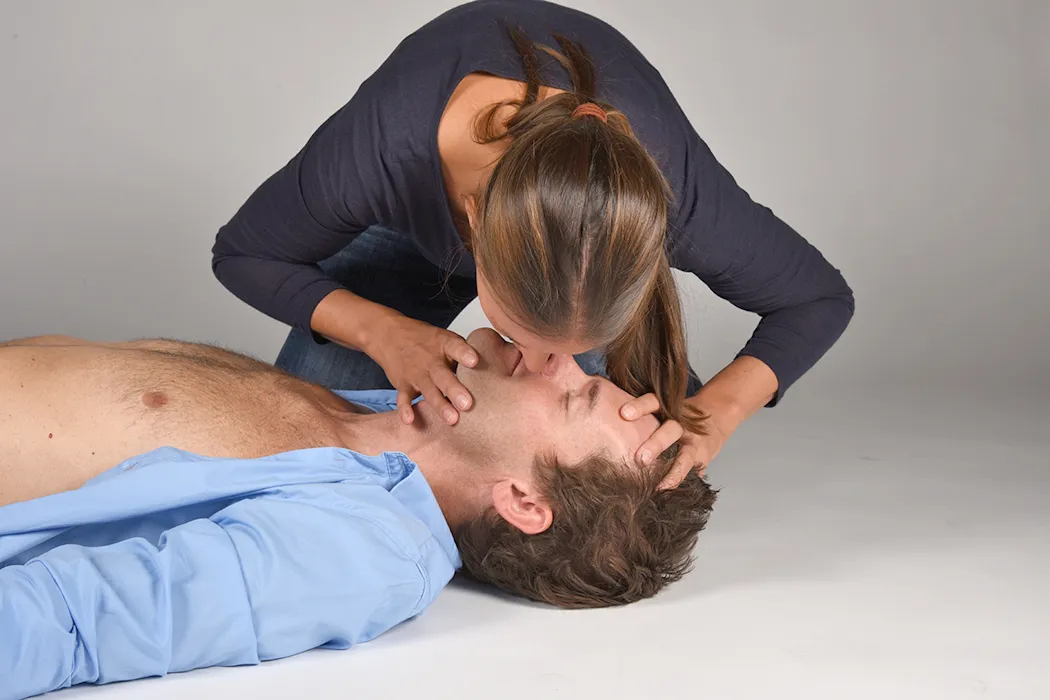
BLS-AED SRC manual
Anyone can help!
If you witness a person collapse: Check if the person is unresponsiv and breathing: immediately alert the Emergency Medical Service (EMS) via the emergency number 144 and start CPR. Do not bother to read the following information, which is designed as additional course material only.
144 for all medical emergencies
Medical Disclaimer
The following statements are made in accordance with (inter)national guidelines, as well as they are updated and revised to the best of our knowledge. They are in no way a substitute for specific training. Their application requires expertise, experience and situational flexibility. The actions described explicitly presuppose the user's mastery of the measures and must not replace or delay alerting the emergency medical service EMS. In case of doubt, consult a physician or emergency medical service EMS.
In two chapters, medications are listed (aspirin for non-traumatic chest pain and epinephrine auto-injector for severe allergic reaction) in accordance with international recommendations. We expressly point out that the legislator in Switzerland legitimizes the corresponding drug administration only for medical professionals, which is why the use or the delegation framework must be clarified in advance and for the specific conditions of the user and institutional setting. In this regard, SIRMED does not assign competencies to first aiders.
Attention: Despite all care taken in the editorial preparation, errors can never be completely excluded. Therefore, no legal guarantee can be assumed for the information provided. The user must always keep up to date with the latest literature. We are grateful for constructive criticism and suggestions for improvement. Any liability claims resulting from the use of the following statements are rejected.
By continuing to read at this point, you declare that you have read and understood the instructions for use and accept the statements on disclaimers and responsibilities in all points.

Most important
A cardiac arrest quickly and in any case ends fatally if no help is provided. The chances of survival can be improved by the immediate help of those present. The basic life-saving measures are easy to learn and to apply. Chest compression has the highest priority. This means:
- your safety is the most important!
- 30 compressions alternating with 2 ventilations
- 100 to 120 compressions per minute
- 5 to 6 cm deep
- defibrillation (AED) can be life-saving
General Information
Self-protection
Information
- For First Responders, their own safety is first priority. An approach to the patient may only be made when it is clear that there is no danger (electricity, gas, traffic, etc.)
- In case of doubt, wait for the arrival of professional rescuers.
Recognition and assessment of emergency situations
Information
- First Aid always begins with an assessment of the situation and the patient.
- It is about recognizing if the patient is acutely threatened and needs immediate life-saving measures.
- Patients can be divided in three groups:
Responsive patient
- Awake or alert and able to respond. Needs can be expressed.
- The patient is able to explain their symptoms.
- Patient may require an ambulance or needs to make an appointment at the doctor.
Unconscious Patient
- Patient is unconscious and does not respond to touch, but is breathing normally.
- Potentially life-threatening
- A recovery position can be life-saving. The aim is to keep the airways open.
- Breathing should be continuously monitored until EMS arrives.
Patient in cardiac arrest- Unconscious and not breathing or not breathing normally (gasping).
- Immediately call for EMS and ask someone to bring an AED.
- Start chest compressions and / or rescue breathing and defibrillation.
Alerting
- In case of serious medical emergencies, EMS is to be called immediately via phone number 144.
- The time between the onset of symptoms and medical assistance should be as short as possible!
- Further emergency numbers:
117 police
118 fire department
145 poison emergency call
1414 rega
112 european emergency number
Causes of cardiac arrest and prevention
Information
- There are many causes for a cardiac arrest. Among the most common are: heart attack, lung embolism, foreign body airway obstruction (FBAO), stroke, serious injury, etc.
- Some risk factors favor heart attack and stroke. Some of these can be influenced. This means that these diseases can be prevented to a certain extent.
- Increased blood lipids, smoking, high blood pressure, overweight, diabetes type 2 and lack of exercise, are avoidable and to a certain extent reduce the personal risk.
Emergency situations
Heart attack
Information
Heart attack is one of the most common causes of death worldwide. In most cases, the blood supply to the heart is interrupted.Recognition
Typical signs of a heart attack are- severe chest pain, pressure or burning
- shortness of breath
- blue discoloration of the lips
- fear
- feeling of impending doom
- nausea, vomiting
- sweat breakout
Action
- For First Responders, recognition and alerting is most important. Do not lose any time!
- Patient should be cared for until EMS arrives.
Stroke
Information
Strokes often end fatally or cause lifelong disabilities. Early detection and hospitalization can be life-saving.Recognition
Typical signs of a stroke are- facial paralysis (when smiling, one side of the face is not moving)
- hemiplegia (the affected person cannot keep the arms stretched out to the same side)
- speech disorders (the affected person cannot speak or is speaking unclearly)
Action
- For First Responders, recognition and alerting is most important. Do not lose any time!
- Patient should be cared for until EMS arrives.
Unconsciousness
Information
- Unconsciousness could be caused by injury, illness or poisoning.
- The biggest danger of an unconscious person is choking on their on vomit, blood or their tongue obstructing the airway while lying on their back.
Recognition
- Person lies motionless on the floor
- Does not respond to speech or touch
- Normal breathing is visible
Action
- Alerting of EMS via emergency number 144
- To keep the airways open, place the patient in the recovery position
- Heat retention, for example by means of a rescue blanket (gold-silver foil)
- Afterwards, continuously check if the patient is breathing until EMS arrives.
Airway obstruction
Information
Airway obstruction can be caused by any kind of foreign matter, especially food, but with small children also toys.Recognition
- Sudden shortness of breath or coughing
- Possibly respiratory arrest
- Asphyxiation fear
- Pale and / or blue skin discoloration
Action
Children under 1 year- 5 back slaps
- 5 chest compressions alternating
Children over 1 and adults
- 5 back slaps
- If unsuccessful: Heimlich maneuver
- and alternate
- For unconsciousness: Basic Life Support
Cardiac arrest
Information
- In Switzerland there is about one cardiac arrest per 1000 inhabitants every year.
- Worldwide only about 12% survive such an event.
Today we know that:
- immediate resuscitation (reanimation) doubles the chances of survival;
- basic life support including defibrillation within 3 to 5 minutes allow survival rates of over 50%;
- every minute delay in defibrillation reduces the chances of survival by about 10%.
- So, do not lose any time!
Defibrillation
Information
- Defibrillation refers to when the patients heart receives a shock. Its' aim is to end ventricular fibrillation.
- Speed is of the essence: For every minute of delayed defibrillation, the chances of survival decrease by about 10%
- After turning on the device, the action steps are carried out to the voice instructions of the device. A single shock is applied, followed by two minutes of CPR. Every 2 minutes the heart rhythm is checked again by the device and, if necessary, another shock is delivered.
Action
- To use a defibrillator, place the patient on a flat surface and dry of the chest if wet.
- Attach pads on to the bare chest as shown in the illustration and press firmly.
- Safety control and shock warning.
- Nobody must touch the patient.
- Perform Basic Life Support while defibrillation is being prepared.
- The interruption for defibrillation must be short.
- After defibrillation, proceed immediately with 30 chest compressions.
Safety instructions
- To ensure a safe defibrillation, some basic rules must be observed:
- Use only on an unconscious and not breathing patient.
- Do not use on conductive surfaces or in explosive environments.
- Defibrillation on snow or ice is not dangerous.
- Heavy chest hair may need to be shaved.
- If the patient has a recognizable pacemaker – attach pads beside it.
- If the patient is wearing medication patches on the chest – remove the patches and wipe the skin.
- With pregnant women, always use a defibrillator.
- Different pictograms are used to signal AED locations. The one shown here is recommended for Switzerland.
Resuscitation is carried out until
- professional rescuers take over the measures;
- the patient is breathing normally again;
- a physician or the rescue team interrupts resuscitation;
- or you become physically exhausted.
Infant resuscitation
Information
- Recognizing if the patient is unconscious in adults and children is the same.
Action
- If the child is unresponsive, phone EMS immediately.
- Start with 5 rescue breaths.
- If there is no response after the 5 rescue breaths, start with 15 compressions, 2 rescue breaths.
- The depth of chest compression is one third of the diameter of the chest.
- Ventilation has a higher priority in resuscitation of children than in adults and should always be performed.
- Pediatric electrodes can be used, if available, when defibrillating children. If not available, normal adult pads should be used.
Legal aspects
Information
- Art 128. of the Swiss Penal Code (StGB) makes it a punishable offense to fail to render assistance in cases of danger to life.
- Wrong or not indicated measures can injure the person concerned.
But:
- No injury is more serious than neglected resuscitation efforts.
- With BLS and AED to the best of one's knowledge and belief, legal consequences are practically excluded
News
Any questions?
Werden Sie jetzt Mitglied und erhalten Sie im Ernstfall 250 000 Franken.


